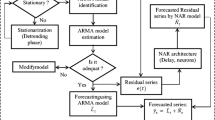Abstract
This study deals with stochastic modeling of solar radiation in all sky conditions and presents an effort to predict and analyze the future trends of monthly insolation based on time series analysis. Multiplicative seasonal autoregressive integrated moving average (ARIMA) model, using Box–Jenkins approach, has been utilized for simulating monthly average insolation data retrieved from NASA POWER (Prediction of Worldwide Energy Resource) data over the study area. The satellite dataset for a period of 34 years has been analyzed for modeling monthly average insolation. The insolation data time series examined by differencing and autocorrelation functions clearly indicates the existence of seasonality. Various multiplicative seasonal ARIMA models developed were validated by assessing various estimation parameters and their performance was evaluated by utilizing different selection measure criterion. The ARIMA (1, 0, 1) × (0, 1, 1)12, possessing minimum value of these criteria, was identified as the most adequate model. Forecasting of insolation was performed through selected models at 95% confidence interval. Results also reveal that ARIMA (1, 0, 1) × (0, 1, 2)12 produces minimum mean percentage error (MPE) in the forecast. As the difference in MPE for ARIMA (1, 0, 1) × (0, 1, 1)12 and ARIMA (1, 0, 1) × (0, 1, 2)12 is marginal (i.e., 0.004), the two models present minimal differences in estimated values and are therefore, reckoned as adequate for forecasting solar radiation.








Similar content being viewed by others
References
Akaike, H. (1974). A new look at the statistical model identification. IEEE Transactions on Automatic Control,19(6), 716–723.
Anand, M., Rajapakse, A. D., & Bagen, B. (2018). Analysis of the quality of long-term synthetic solar radiation data generated from stochastic models. In 2018 IEEE international conference on probabilistic methods applied to power systems (PMAPS) (pp. 1–6), Boise, ID, USA, 24–28 June 2018. https://doi.org/10.1109/PMAPS.2018.8440560.
Atique, S., Noureen, S., Roy, V., Subburaj, V., Bayne, S., & Macfie, J. (2019). Forecasting of total daily solar energy generation using ARIMA: A case study. In 2019 IEEE 9th annual computing and communication workshop and conference (CCWC) (pp. 0114–0119), Las Vegas, NV, USA, 7–9 January 2019. https://doi.org/10.1109/CCWC.2019.8666481.
Ayodele, T., Ogunjuyigbe, A., & Monyei, C. G. (2016). On the global solar radiation prediction methods. Journal of Renewable and Sustainable Energy,8(2), 023702.
Besharat, F., Dehghan, A. A., & Faghih, A. R. (2013). Empirical models for estimating global solar radiation: A review and case study. Renewable and Sustainable Energy Reviews,21, 798–821.
Bhardwaj, S., Sharma, V., Srivastava, S., Sastry, O., Bandyopadhyay, B., Chandel, S., et al. (2013). Estimation of solar radiation using a combination of Hidden Markov Model and generalized Fuzzy model. Solar Energy,93, 43–54.
Blaga, R., Sabadus, A., Stefu, N., Dughir, C., Paulescu, M., & Badescu, V. (2019). A current perspective on the accuracy of incoming solar energy forecasting. Progress in Energy and Combustion Science,70, 119–144.
Box, G. E., Jenkins, G. M., Reinsel, G. C., & Ljung, G. M. (2015). Time series analysis: Forecasting and control. New York: Wiley.
Bulut, H., & Büyükalaca, O. (2007). Simple model for the generation of daily global solar-radiation data in Turkey. Applied Energy,84(5), 477–491.
Chatfield, C. (2000). Time-series forecasting. London: Chapman and Hall/CRC.
Colak, I., Yesilbudak, M., Genc, N., & Bayindir, R. (2015). Multi-period prediction of solar radiation using ARMA and ARIMA models. In 2015 IEEE 14th international conference on machine learning and applications (ICMLA) (pp. 1045–1049), Miami, FL, 9–11 December 2015. https://doi.org/10.1109/ICMLA.2015.33.
Deo, R. C., & Şahin, M. (2017). Forecasting long-term global solar radiation with an ANN algorithm coupled with satellite-derived (MODIS) land surface temperature (LST) for regional locations in Queensland. Renewable and Sustainable Energy Reviews,72, 828–848.
Etuk, E. H. (2012). A multiplicative seasonal ARIMA model for Nigerian unemployment rates. Bulletin of Society for Mathematical Services and Standards,1, 57–67.
Fouilloy, A., Voyant, C., Notton, G., Motte, F., Paoli, C., Nivet, M. L., et al. (2018). Solar irradiation prediction with machine learning: Forecasting models selection method depending on weather variability. Energy,165, 620–629.
Francis, P., & Gadgil, S. (2010). Towards understanding the unusual Indian monsoon in 2009. Journal of Earth System Science,119(4), 397–415.
Gairaa, K., Khellaf, A., Messlem, Y., & Chellali, F. (2016). Estimation of the daily global solar radiation based on Box-Jenkins and ANN models: A combined approach. Renewable and Sustainable Energy Reviews,57, 238–249.
Ghofrani, M., & Suherli, A. (2017). Time series and renewable energy forecasting. In N. Mohamudally (Ed.), Time series analysis and applications (pp. 77–92). IntechOpen. https://doi.org/10.5772/intechopen.70845. https://www.intechopen.com/books/time-series-analysis-and-applications/time-series-and-renewable-energy-forecasting. Accessed 18 Aug 2019.
Guermoui, M., Melgani, F., & Danilo, C. (2018). Multi-step ahead forecasting of daily global and direct solar radiation: A review and case study of Ghardaia region. Journal of Cleaner Production,201, 716–734.
Halawa, E., GhaffarianHoseini, A., & Li, D. H. W. (2014). Empirical correlations as a means for estimating monthly average daily global radiation: A critical overview. Renewable Energy,72, 149–153.
Hammer, A., Heinemann, D., Lorenz, E., & Lückehe, B. (1999). Short-term forecasting of solar radiation: A statistical approach using satellite data. Solar Energy,67(1–3), 139–150.
Hassan, J. (2014). ARIMA and regression models for prediction of daily and monthly clearness index. Renewable Energy,68, 421–427.
Hejase, H. A., & Assi, A. H. (2012). Time-series regression model for prediction of mean daily global solar radiation in Al-Ain, UAE. ISRN Renewable Energy, 2012, 412471. https://doi.org/10.5402/2012/412471.
Hocaoğlu, F. O. (2011). Stochastic approach for daily solar radiation modelling. Solar Energy,85(2), 278–287.
Huang, R., Huang, T., Gadh, R., & Li, N. (2012). Solar generation prediction using the ARMA model in a laboratory-level micro-grid. In 2012 IEEE third international conference on smart grid communications (SmartGridComm) (pp. 528–533), Tainan, Taiwan, 5–8 November 2012. https://doi.org/10.1109/SmartGridComm.2012.6486039.
Hussain, S., & Al Alili, A. (2016). Day ahead hourly forecast of solar irradiance for Abu Dhabi, UAE. In 2016 IEEE smart energy grid engineering (SEGE) (pp. 68–71), Oshawa, ON, Canada, 21–24 August 2016. https://doi.org/10.1109/SEGE.2016.7589502.
Hyndman, R. J. (2001). ARIMA processes. https://datajobs.com/data-science-repo/ARIMA-Intro-[Hyndman].pdf. Accessed 18 Sept 2019.
Ibrahim, I. A., & Khatib, T. (2017). A novel hybrid model for hourly global solar radiation prediction using random forests technique and firefly algorithm. Energy Conversion and Management,138, 413–425.
Inman, R. H., Pedro, H. T., & Coimbra, C. F. (2013). Solar forecasting methods for renewable energy integration. Progress in Energy and Combustion Science,39(6), 535–576.
Ji, W., & Chee, K. C. (2011). Prediction of hourly solar radiation using a novel hybrid model of ARMA and TDNN. Solar Energy,85(5), 808–817.
Kärner, O. (2009). ARIMA representation for daily solar irradiance and surface air temperature time series. Journal of Atmospheric and Solar-Terrestrial Physics,71(8–9), 841–847.
Kumar, R., Aggarwal, R., & Sharma, J. (2015). Comparison of regression and artificial neural network models for estimation of global solar radiations. Renewable and Sustainable Energy Reviews,52, 1294–1299.
Ljung, G. M., & Box, G. E. (1978). On a measure of lack of fit in time series models. Biometrika,65(2), 297–303.
Masoom, A., Kashyap, Y., & Bansal, A. (2019). Solar radiation assessment and forecasting using satellite data, advances in solar energy research (pp. 45–71). New York: Springer.
McLeod, A. I. (1993). Parsimony, model adequacy and periodic correlation in time series forecasting. International Statistical Review/Revue Internationale de Statistique, 61(3), 387–393. https://doi.org/10.2307/1403750.
Mohan, S., & Vedula, S. (1995). Multiplicative seasonal ARIMA model for longterm forecasting of inflows. Water Resources Management,9(2), 115–126.
Montgomery, D. C., Jennings, C. L., & Kulahci, M. (2015). Introduction to time series analysis and forecasting. New York: Wiley.
Neena, J., Suhas, E., & Goswami, B. (2011). Leading role of internal dynamics in the 2009 Indian summer monsoon drought. Journal of Geophysical Research Atmospheres, 116, D13103. https://doi.org/10.1029/2010JD015328.
Paulescu, M., Pop, N., Stefu, N., Paulescu, E., Boata, R., & Calinoiu, D. (2017). Seasonal modeling of hourly solar irradiation series. Romanian Journal of Physics,62(7–8), 58–71.
Perez, R., Ineichen, P., Moore, K., Kmiecik, M., Chain, C., George, R., et al. (2002). A new operational model for satellite-derived irradiances: description and validation. Solar Energy,73(5), 307–317.
Qazi, A., Fayaz, H., Wadi, A., Raj, R. G., Rahim, N., & Khan, W. A. (2015). The artificial neural network for solar radiation prediction and designing solar systems: A systematic literature review. Journal of Cleaner Production,104, 1–12.
Reikard, G. (2009). Predicting solar radiation at high resolutions: A comparison of time series forecasts. Solar Energy,83(3), 342–349.
Ren, Y., Suganthan, P., & Srikanth, N. (2015). Ensemble methods for wind and solar power forecasting—A state-of-the-art review. Renewable and Sustainable Energy Reviews,50, 82–91.
Schwarz, G. (1978). Estimating the dimension of a model. The Annals of Statistics, 6(2), 461–464.
Sen, Z. (2008). Solar energy fundamentals and modeling techniques: Atmosphere, environment, climate change and renewable energy. New York: Springer.
Sengupta, M., Habte, A., Gueymard, C., Wilbert, S., & Renne, D. (2017). Best practices handbook for the collection and use of solar resource data for solar energy applications. Golden: National Renewable Energy Lab (NREL).
Sfetsos, A., & Coonick, A. (2000). Univariate and multivariate forecasting of hourly solar radiation with artificial intelligence techniques. Solar Energy,68(2), 169–178.
Shams, M. B., Haji, S., Salman, A., Abdali, H., & Alsaffar, A. (2016). Time series analysis of Bahrain’s first hybrid renewable energy system. Energy,103, 1–15.
Stackhouse Jr., P. W., Zhang, T., Westberg, D., Barnett, A. J., Bristow, T., Macpherson, B., Hoell, J. M., & Hamilton, B. A. (2018). POWER release 8 (with GIS applications) methodology (data parameters, sources, & validation) documentation (data version 8.0.1). https://power.larc.nasa.gov/new/files/POWER_Data_v8_methodology.pdf. Accessed 18 Sept 2019.
Sulaiman, M. Y., Wahab, M. A., & Sulaiman, Z. A. (1997). Analysis of residuals in daily solar radiation time series. Renewable Energy,11(1), 97–105.
Taneja, K., Ahmad, S., Ahmad, K., & Attri, S. (2016). Time series analysis of aerosol optical depth over New Delhi using Box-Jenkins ARIMA modeling approach. Atmospheric Pollution Research,7(4), 585–596.
Voyant, C., Notton, G., Kalogirou, S., Nivet, M.-L., Paoli, C., Motte, F., et al. (2017). Machine learning methods for solar radiation forecasting: A review. Renewable Energy,105, 569–582.
Wu, G., Liu, Y., & Wang, T. (2007). Methods and strategy for modeling daily global solar radiation with measured meteorological data—A case study in Nanchang station, China. Energy Conversion and Management,48(9), 2447–2452.
Yadav, A. K., & Chandel, S. (2014). Solar radiation prediction using artificial neural network techniques: A review. Renewable and Sustainable Energy Reviews,33, 772–781.
Zaharim, A., Razali, A. M., Gim, T. P., & Sopian, K. (2009). Time series analysis of solar radiation data in the tropics. European Journal of Scientific Research,25(4), 672–678.
Acknowledgements
Authors wish to acknowledge anonymous reviewers for useful comments and suggestions to improve the manuscript and the NASA Langley Research Center (LaRC) POWER Project funded through the NASA Earth Science/Applied Science Program.
Author information
Authors and Affiliations
Corresponding author
Ethics declarations
Conflict of interest
Authors declare no conflict of interest.
Rights and permissions
About this article
Cite this article
Shadab, A., Said, S. & Ahmad, S. Box–Jenkins multiplicative ARIMA modeling for prediction of solar radiation: a case study. Int J Energ Water Res 3, 305–318 (2019). https://doi.org/10.1007/s42108-019-00037-5
Received:
Accepted:
Published:
Issue Date:
DOI: https://doi.org/10.1007/s42108-019-00037-5




